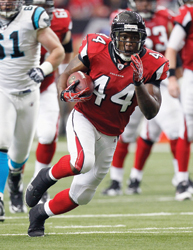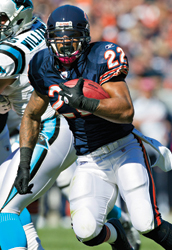When the NFL draft starts on Thursday night, free agent running back Ryan Grant and his agent, Alan Herman, will be watching with special interest to see who picks Trent Richardson.
Grant rushed for 559 yards for Green Bay last season and has two earlier 1,200-yard-plus seasons to his credit, yet he is one of a number of running backs who, as of last week, was still unsigned more than a month into NFL free agency. In the past, a running back who contributed to a winning team would usually have signed by this time of year, but Herman hasn’t received any serious offers.
 |
Free agent Ryan Grant, without any serious offers, will watch the draft with interest.
Photo by: GETTY IMAGES
|
Herman is hoping that will change after the draft, especially for the teams that are hoping but aren’t able to draft Richardson.
“There are two or three teams out there who could use a solid back,” Herman said. “Whoever takes Richardson — you remove [that club]; I think Ryan’s chances of finding a job are excellent.”
The fact that it’s come to this, however, is notable for Herman, who has been an NFL agent for 29 years and has represented players at every position. Herman said he can’t think of a time when there was less demand for running backs than there is in today’s NFL. “It’s been a horrendous market across the board,” he said.
Herman is one of only a few player representatives who was willing to say publicly what agents have been grumbling about privately for at least a year now: that the running back position, once a glamour position on an NFL team, has lost its luster. There’s evidence in the number of running backs without jobs who are still on the market. The league’s new collective-bargaining agreement and the fact that the NFL in recent years has become a pass-heavy league are notable. An examination of the draft over the past decade shows how few teams are willing to use their top draft picks on running backs.
NFL teams, in general, are increasingly reluctant to commit top dollars to players at a position that arguably is one of the most punishing in all of sports.
MARKING THE TREND
Richardson, out of Alabama, is seen as a high first-round pick, with many mock drafts last week slotting him as high as No. 4 overall. He also, however, could stand as the only first-round running back selected. If that were to happen, his solo selection would match what happened in last year’s draft, when Mark Ingram was the only running back taken in the first round, at No. 28 overall. Never before over the past decade had there been only one running back picked in the first round.
“Last year, there was just one, and this year it appears, it’s just one,” said Todd McShay, NFL draft analyst for ESPN. “Last year and this year, there is just one true first-round talent.”
Miami running back Lamar Miller, a client of Drew Rosenhaus, has drawn some attention as a potential first-round pick, but his selection would likely be much lower in the first round than Richardson, if at all. In that sense, a Miller first-round pick would perhaps be even more reflective of the recent plight of rookie running backs in the NFL than Richardson.
While the number of first-round running backs selected in the draft annually between 2002 and 2010 was more than last year’s single pick (Ingram), most of those picks have not been high first-round picks — the type of player to command the largest contracts with the most guaranteed, up-front dollars (see chart).
If teams are picking running backs in the first round at all, they’re tending to select them lower in the round. McShay noted there also now are running backs who would go in the second round in past years going in the third or fourth round now.
So what has happened?
According to a number of agents, the NFL lockout and the rules in the new CBA may have contributed to the current situation.
Prior to the March 2011 expiration of the league’s old CBA, there were changes in the league rules that governed which players were eligible for unrestricted free agency. Under the old CBA, players could be unrestricted free agents after four years in the league. That changed in 2010 to six years of service, a development stemming from the 2010 season becoming an uncapped season in what ultimately would become the last league year prior to the 2011 lockout.
As a result of the change, in 2010, there were fewer unrestricted free agents and more restricted free agents, and most of those restricted free agents signed one-year tenders with the clubs. When the lockout ended, this wave of players came onto the market together. That increase in supply negatively affected what players at all positions could draw for individual contracts, but for running backs especially, it made it particularly difficult. Clubs just don’t want to commit to multiyear deals with players at such an injury-prone position — especially when there are so many such players looking for jobs.
 |
Jason Snelling re-signed with the Falcons rather than test a risky free agent market.
Photo by: GETTY IMAGES
|
Such has been the case this year, as well. In fact, it played a major part in the decision of Atlanta running back Jason Snelling signing a three-year, $4 million extension in early March, said his agent, Scott Smith, who with his partner Jason Bernstein at XAM Sports negotiated Snelling’s deal.
“We decided it was in Snelling’s best interest to pull the trigger on the deal and not go into this free agent market,” Smith said.
Smith and Bernstein’s research showed that there was an abundance of free agent running backs across the last two years. According to those XAM numbers, there were 40 free agent running backs available this year and 45 last year — compared with 16 in 2010 and 30 in 2009.
Additionally, under the new CBA that was agreed to last year, franchise tags are calculated differently than they were in the past, using the average of what the top players at the position make over the previous five years instead of the previous year. The franchise tag for running backs is $7.7 million this year, down from $9.6 million in 2011 and $8.2 million in 2010. That gives teams yet another option to avoid committing multiyear contracts (and dollars) to running backs looking for longer-term and higher-value deals.
AGENTS SHYING AWAY
Put the elements together, and at least one veteran agent said he is not even trying to sign running backs anymore.
“We have purposely stayed out of the running back market for the last four or five years,” this agent said. “The system is not set up for running backs because their shelf life is so short. You need four years to be a free agent, and at six or seven years, the wheels start falling off the bus. I don’t want to sign them because I don’t want to do holdouts with players.”
The agent, who has held star NFL players out of team camps in the past to get contracts done, said that holding out running backs may be the only way to get leverage over the clubs. This agent, as well as several others, noted running backs Ray Rice and Matt Forte specifically, contending that they should hold out rather than accept the one-year franchise tags they’ve been offered by Baltimore and Chicago, respectively.
“Matt Forte and Ray Rice?” the agent said. “They haven’t made a dime. They have killed their bodies for four years and they haven’t gotten paid.”
The numbers: Rice rushed for more than 1,300 yards last year, the third consecutive season he’s surpassed 1,200 yards. Forte posted just under 1,000 yards last year before a knee injury ended his season in early December.
Each is now seeking a new, longer-term contract having completed four seasons in the league.
Rice’s agent, Todd France, did not return a phone call. Adisa Bakari,
 |
Agents recommended that Ray Rice (top) and Matt Forte should hold out rather than accept the one-year franchise tags they have been offered by their teams.
Photos by: GETTY IMAGES (2)
|
Forte’s agent, declined to comment. But both Rice and Forte have suggested publicly that they were unhappy with being tagged by their teams. As Forte tweeted in late March, “There’s only so many times a man that has done everything he’s been asked to do can be disrespected!”
Agents say Forte and Rice aren’t the only unhappy running backs out there. They also say these running backs are starting to take out some of their frustrations on the people hired to secure their contracts — their own agents.
Consider Peyton Hillis. He was the surprise winner of a fan vote for the cover of “Madden NFL 2012” and rode that wave of popularity into the 2011 season. Ultimately, however, he’s changed agents three times in the last year. He was originally with veteran agent Jimmy Sexton. He left Sexton for two other agents whom he later fired. After signing back with Sexton earlier this year, he agreed to a one-year, $3 million deal with Kansas City for the 2012 season.
Similarly, Philadelphia’s LeSean McCoy, who was reportedly unhappy with what he was being paid by the team last year, fired and rehired agent Drew Rosenhaus twice last season.
Cedric Benson, who rushed for more than 1,000 yards last year for Cincinnati, is, like Grant, an unrestricted free agent this summer. He also, like Grant, was still without a job late last week. As is the case with Grant’s agent, Benson’s agent, Eugene Parker, thinks his client ultimately will get a job with a club “who didn’t get what they wanted in the draft.”
“Cedric is a proven commodity,” Parker said. He added that while he doesn’t think the running back position has necessarily gone down in value in recent years, it clearly hasn’t gone up, either — such as it has, for example, for the wide receiver position. One big reason: “The league,” Parker said, “is going more to the passing game.”
A CHANGING GAME
NFL clubs collectively set records not only for scoring but also for passing last year. Quarterbacks threw for 117,606 yards in 2011, the third straight season in which a new record was set, and up more than 8 percent from the total of 2002. On the scoreboard, an average of 44.4 points were scored per game, a second consecutive annual increase.
Joel Bussert, NFL senior vice president of football operations, said he couldn’t pinpoint a reason for the increases, including whether the loss of normal spring activities and shorter training camps because of last year’s lockout played a factor. The increases, however, are far from a point of concern for the league.
“Fans don’t complain about high-scoring games,” said Greg Aiello, NFL senior vice president of communications.
But are the increase in passing yards and tougher times for running backs here to stay? Rich McKay, president of the Atlanta Falcons and chairman of the NFL competition committee, noted that different positions have held different market values over time.
“There was a time in the mid-1990s when defensive ends went from $3.5 million a year to $6 million a year, in one year,” McKay said. In addition, the Falcons in 2008 signed their No. 1 running back, Michael Turner, to a six-year, $34 million contract, with $15 million guaranteed. “[Turner] didn’t have that big of a market … but we were willing to pay him and pay substantially to sign him,” McKay said.
But heading into draft week, with new, young players available right out of college, veteran NFL players will have to sit and watch.
“There is a feeling in league circles that they can get a running back at any point in the draft,” said Mike McCartney, agent for Houston Texans running back Arian Foster and partner at Priority Sports & Entertainment. “It makes extending a running back very challenging.”
Foster signed a three-year deal with the Texans in 2009 as an undrafted rookie free agent, but he far outplayed his draft status, making the Pro Bowl in 2010 and 2011. After last season, he would have been a restricted free agent, but the Texans this spring rewarded him with a five-year, $43.5 million extension, with $21 million guaranteed.
“I give a ton of credit to the Houston Texans, because they had the rights to Arian Foster for at least two to three years, and the easiest thing for a club to do is sit back and wait, especially knowing that running backs have a shorter shelf life,” McCartney said. “The Texans didn’t do that.”
Nor did they put a one-year tag on Foster this year, something they could have done next year as well, McCartney said.
“They could have pounded us and we would have been stuck,” he said. “But they took care of their best player.”
Which teams across the league take care of which running backs this year, and how, will start to become more clear once the draft begins on Thursday night.







